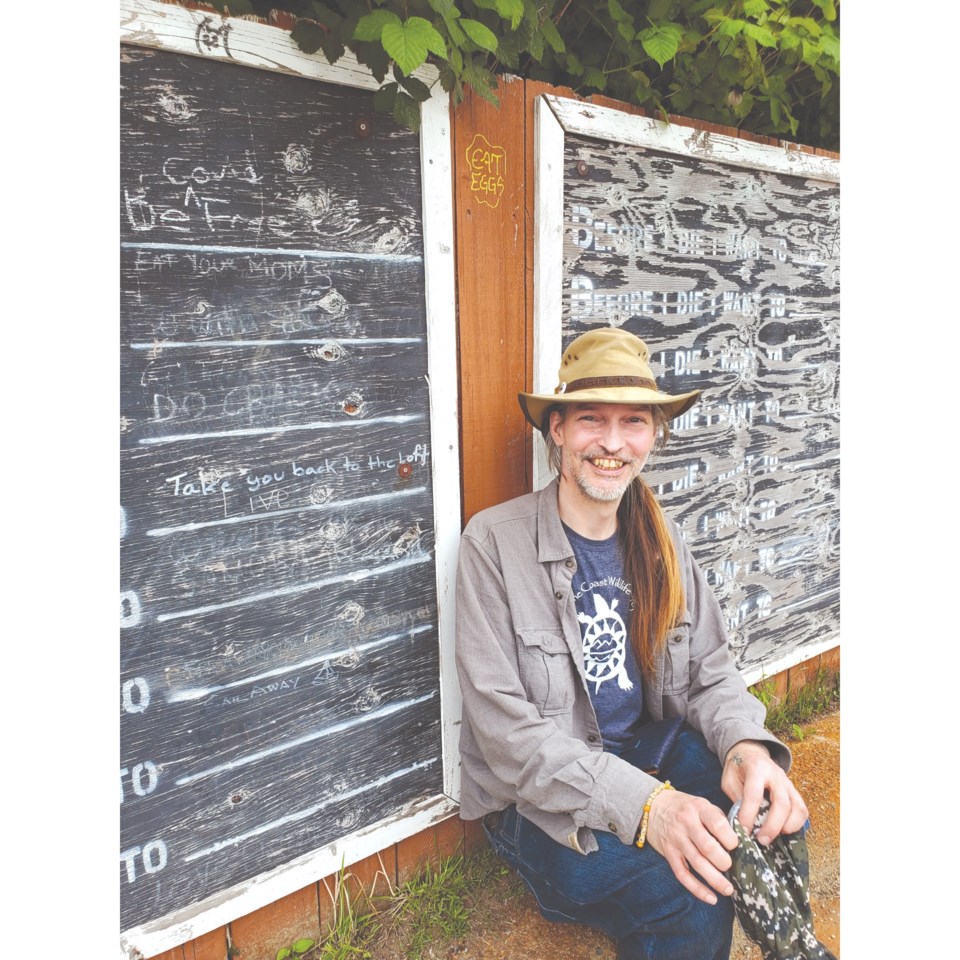There’s a community art project that’s been up for some time along the Gibsons waterfront – a blackboard with the line, “Before I die I want to…”
“…canoe over to Keats,” reads one of the blanks filled in below.
“…build a little red house.”
“…see you smile.”
“[It was] to raise awareness about the fact that people who use drugs are people who have aspirations beyond just using drugs or dying,” explained Brian Mackenzie, a long-time peer support worker based out of Gibsons. Mackenzie and his husband Kenn Quayle (“One of the first people to spearhead peer-based harm reduction in Canada,” says Mackenzie) run the i2i Peer Support Project. i2i received funding in late 2021 for peer support, as well as advocacy for safe supply.
(Added note: Such boards exist in other places in Canada, such as Toronto and Vancouver, and are an anti-stigma project rather than memorials for individual people who've passed.)
“That’s what the coroner and the Prime Minister and others have emphasized as being the key to saving people’s lives,” said Mackenzie. “The cause of people dying in droves is the toxic drug supply, so if we want to stop them from dying so frequently, we need to provide them with drugs that are non-toxic.”
In July 2021, the province announced funding of up to $22.6 million to go toward planning, phased implementation, monitoring and evaluation of prescribed safer supply.
The majority of the funding i2i received is earmarked for hosting meetings to consult with people in the community who are at risk of overdose about their level of awareness of safe supply options and getting their input.
“It will be great to see more peer engagement and more opportunities for peers to advocate for what they want to see on the Coast to make a difference,” says Ciara Knapp project coordinator of the Sunshine Coast Community Action Team (CAT). (Knapp defines a peer as a “person with lived or living experience.”) The group is one of 35 across B.C. dedicated to addressing the overdose crisis at a community level. Community members involved with the team range from the mayor of Sechelt to peers to RainCity to Arrowhead.
“We all come together, figure out what type of goals and milestones we want to have each year with our funding, and work on it together,” said Knapp.
There have been more grants available lately for overdose response, said Knapp, but for i2i, “This is the first time that they’ve had funding for it to be able to actually create a peer network,” she said. “Before that, we just had CAT funding specifically for having peer engagement and peer education. Now we can collaborate on that together, which is really good.”
Between 2020 and 2021, overdose responses from BC Emergency Health Services in Sechelt doubled – from 41 to 87. In 2021, the numbers were down a little bit to 83. In Gibsons, on the other hand, there were 37 overdose calls in 2021, up from 24 in 2020, and 34 in 2019. Data from the BC Coroners Service released last week shows that 12 of the 2,224 people who died in B.C. last year from “illicit drug toxicity” were on the Sunshine Coast (though it’s not clear if this includes the upper and lower Sunshine Coast).
And the drugs are just getting more toxic. Emergency Health Services says paramedics are administering more Naloxone than ever before.
“It’s a new crisis,” said Mackenzie. “With the COVID situation, fentanyl has gone from just being an ingredient that was contaminating the drug supply to being the main thing.”
This affects the effectiveness of safe supply medications. “This quote unquote heroin supply now is dominated by pure fentanyl, which is way beyond what the previous medications like methadone are able to really help people resist the pull of the illegal drugs,” said Mackenzie.
Dr. Joerg Jaschinski, one of the doctors at Sechelt’s opioid agonist treatment clinic and part of the Sunshine Coast Opioid Overdose Prevention Task Force, says that more than 100 people are making use of the safe supply options available on the Coast. While initially the doctors were resistant to offering the higher strength hydromorphone (similar to heroin), it took just a couple of weeks for them to get over that, said Jaschinski. The relative safety of the safe supply from the street supply became clear.
There are complexities around the strength of safe supply available, the restrictions around giving out the supply and shortage of health industry workers.
For Knapp and Mackenzie, stigma remains an overarching issue in the overdose crisis.
“There’s still stigma towards people who use substances, and that stigma can be isolating and shaming,” said Knapp. It means that people don’t get connected with the resources that could be helpful. “We know that the majority of overdose deaths are because people are using alone.” Knapp shares that there are resources like the Lifeguard app and the Be Brave app,
For Mackenzie, there’s a need for more resources put toward peer support. “We talk a good talk in Canada, there’s a lot of good written policy, but in actual practice, there’s a lot of entrenched stigma in the system.
“Because of the stigma, very few resources are put into supporting programs like ours that are trying to deal with it on the ground and with the people that are most involved.”
See more about i2i : facebook.com/The-i2i-Peer-Support-Project-356342251545720.



